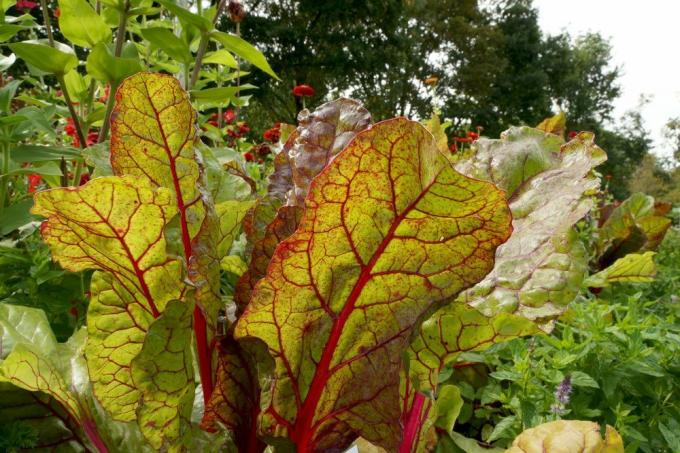
table of contents
- Swiss chard
- Raw consumption
- Oxalic acid content
- Poisoning prevention
- Chard species
- origin
- taste
- ingredients
Mangold was valid until the 19th Century as a delicacy, but then the green leaves almost completely disappeared from the menu. In the meantime, however, the Swiss chard is finding its way back into the kitchen. The taste is reminiscent of spinach, but can it be consumed in the same way? How healthy are the vegetables and how many vitamins do they contain?
Swiss chard
Eat raw?
Basically, Swiss chard is very healthy and with a calorie content of 19 kcal per 100 grams, it is a great addition to a calorie-conscious diet. However, there are restrictions on consumption, especially when consumed raw!
Swiss chard contains oxalic acid, which can be toxic to humans and animals. The cooking process significantly reduces the acidity and it is safe for people to consume. However, if large quantities of Swiss chard are eaten raw, symptoms of poisoning can occur.

Raw consumption
What happens when chard is eaten raw?
Not everyone reacts to the consumption of oxalic acid, which is contained in Swiss chard, with symptoms of poisoning. Often nothing happens or there is little discomfort. The risk of symptoms increases in line with the dose consumed. The following symptoms may occur depending on the amount consumed.
- Adhesion of the kidney tubules
- Calcium deficiency
- Kidney stones
- Gastrointestinal complaints
Adhesion of the kidney tubules:
Oxalic acid, which is contained in Swiss chard, together with the calcium consumed forms a substance in the human intestine that is no longer soluble. This substance is called calcium oxalate. The calcium oxalate gets into the kidney tubules through the natural circulation and can block them. This can lead to the development of kidney stones, which in the worst case have to be surgically removed.
Calcium deficiency:
Since oxalic acid combines with calcium and removes it from the body, there is a risk of calcium deficiency. This deficiency in turn has the following symptoms.
- Drop in blood pressure
- Pulse irregularity
- Cramps in the legs
- Water retention
- Vomiting and diarrhea
- Circulatory collapse
People who already suffer from low calcium levels or who have already been diagnosed with osteoporosis are particularly at risk.

Oxalic acid content
How high is the oxalic acid content of Swiss chard?
Swiss chard is by no means the only vegetable that should not be eaten raw due to its oxalic acid content. The similar taste spinach, rhubarb and beetroot also contain the substance. Cocoa powder contains a particularly large amount, which can only be consumed in small quantities.
Oxal content:
- Swiss chard: 110-900 MG per 100 grams
- Spinach: 120-1300 MG per 100 grams
- Rhubarb: 180 - 760 MG per 100 grams
- Red berry: 17 - 405 MG per 100 grams
- Cocoa powder: 338 - 645 MG per 100 grams
Poisoning prevention
How can poisoning be prevented?
If the chard is consumed cooked, the content of oxalic acid is reduced to a safe level. Small amounts of raw vegetables are usually tolerated, but to compensate for and prevent a calcium deficiency, it is advisable to consume additional calcium. Calcium should be absorbed at least two hours after consuming raw Swiss chard.
Chard species
What types of chard are there?
There are different types of Swiss chard, which differ both visually and in terms of taste.
There are the following types:
- Stalked chard
- Chard leaf
Of the Stalked chard has distinctive stems that are popular as a substitute for asparagus. The stalks also serve as an addition to the salad, but only in tiny amounts here due to the oxalic acid content.
Chard leaf has large leaves that are up to 30 cm in length. reachable. The leaves curl at the ends and the stems are much narrower.

origin
Where does Swiss chard come from?
The history of the chard goes back to ancient times. There the vegetables grew as wild growth in the area of the Mediterranean Sea. In the meantime, Swiss chard also grows in large parts of Europe, but only very rarely in Germany.
taste
How does Swiss chard taste when consumed?
Swiss chard is reminiscent of spinach both visually and in terms of preparation, but the two types of vegetable differ in taste. The spinach tastes milder, less intense, the taste of chard dominates and is slightly tart.
The stem vegetables also taste mild, reminiscent of green asparagus and go well with stews, salads and as vegetables.

ingredients
Is Swiss chard healthy or unhealthy?
Swiss chard is considered a natural medicinal plant and was used in ancient times to treat various ailments. Both intestinal sluggishness and mental illnesses such as restlessness and nervousness were treated. The mineral content is good, Swiss chard is considered healthy and nutritious.
- Swiss chard has a protein content of 2.1 grams per 100 grams
- the fat content is 0.3 grams
- the proportion of carbohydrates is 0.7 grams
- the vegetables are also high in iron, potassium, calcium, magnesium and sodium

